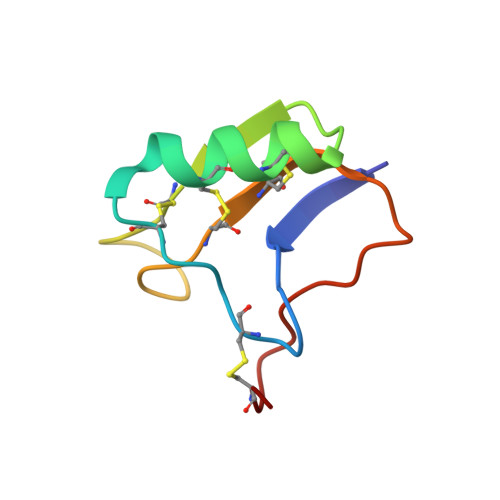Solution Structure of BmKalphaIT01, an alpha-Insect Toxin from the Venom of the Chinese Scorpion Buthus martensii Karsch
Tong, X., Zhu, J., Ma, Y., Chen, X., Wu, G., He, F., Cao, C., Wu, H.(2007) Biochemistry 46: 11322-11330
- PubMed: 17877370
- DOI: https://doi.org/10.1021/bi7006788
- Primary Citation of Related Structures:
2E0H - PubMed Abstract:
The solution structure of an alpha-insect toxin from Buthus martensii Karsch, BmKalphaIT01, has been determined by two-dimensional NMR spectroscopy and molecular modeling techniques. Combining the sequence homology comparison and toxicity bioassays, BmKalphaIT01 has been suggested to be a natural mutant of alpha-insect toxins and so can serve as a tool to study the relationship of structure-function among this group of toxins. The overall structure of BmKalphaIT01 shares a common core structure consisting of an alpha-helix packed against a three-stranded antiparallel beta-sheet, which exhibits distinctive local conformations within the loops connecting these secondary structure elements. The solution structure of BmKalphaIT01 features a non-proline cis peptide bond between Asn9 and Tyr10, which is proposed to mediate the spatial closing of the five-residue turn (Gln8-Cys12) and the C-terminal segment (Arg58-His64) to form the NC domain and confer the toxin insect-specific bioactivity. Conformational heterogeneity is observed in the solution of BmKalphaIT01 and could be attributed to the cis-trans isomerization of the peptide bond between residues 9 and 10. The minor conformation of BmKalphaIT01 with a trans peptide bond between Asn9 and Tyr10 may be responsible for its moderate bioactivity against mammals. The cis-trans isomerization of the peptide bond between residues 9 and 10 may be the structural basis of dual pharmacological activities of alpha-insect and alpha-like scorpion toxins, which is supported by the fact that conformational heterogeneity occurs in the solution structures of LqhalphaIT, LqqIII, and LqhIII and by comparison of the solution structure of BmKalphaIT01 with those of some relevant alpha-type toxins.
Organizational Affiliation:
State Key Laboratory of Bio-organic and Natural Products Chemistry, Shanghai Institute of Organic Chemistry, Chinese Academy of Sciences, Shanghai 200032, China.














